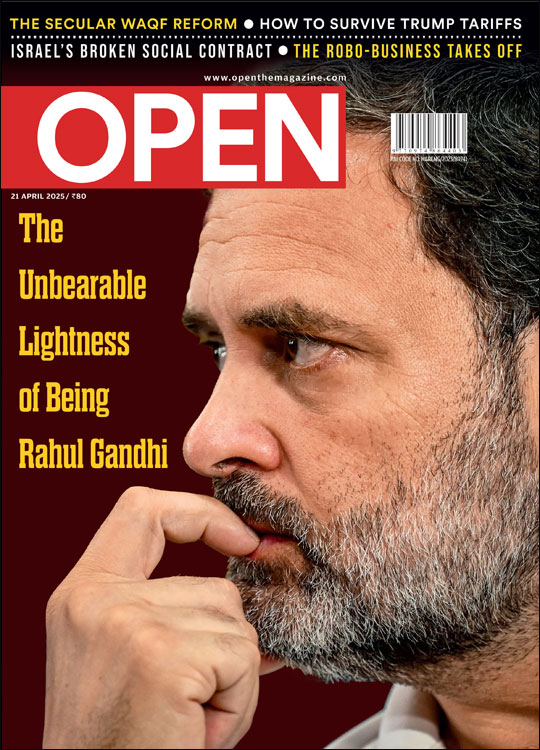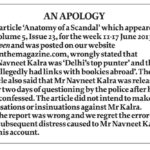THE ROYAL COMMONER
This descendant of the Darbhanga dynasty of Bihar believes that historians have ignored the good deeds of her ancestors. The 33-year-old says that family fortunes began to decline from the time of her grandfather Visheshwar Singh
/wp-content/uploads/2015/11/Royalcommober1.jpg)
This descendant of the Darbhanga dynasty of Bihar believes that historians have ignored the good deeds of her ancestors. The 33-year-old says that family fortunes began to decline from the time of her grandfather Visheshwar Singh
Kumud Singh has had an unusual childhood. Born into the royal family of Darbhanga, also known as the Khandavala dynasty, in the early 1980s, her early childhood memories are of growing up on an estate of 51 bighas in Bargoria, now in West Bengal, along with three elephants and some 100 people, including members of the family, extended family, numerous house helps, hangers-on and bodyguards. Over the next decade or so, she saw her home shrink rapidly and all the elephants and most dependants disappear. “Many of the orderlies and bodyguards got richer than us,” she recalls. A descendant of a family that once commanded the destinies of people spread across more than 6,000 sq km, including parts of Bihar and West Bengal, a family which owned the Rambagh Palace, the Lakshmeshwar Vilas Palace, the Nargona Palace, the Bela Palace, as well as properties in almost every prominent city in British India, by the time Kumud was a young adult, there was no television, refrigerator or computer at home. “I learnt the uses of all these only after I got married in 2002. I had never watched television programmes before,” says the bespectacled lady, seated attentively in the verandah of her husband’s modest home in the quiet Sri Krishna Puri locality of Patna.
Her father Nandeshwar Singh, now 59, lives with her mother and a few relatives on what now remains of the estate in Bargoria. “There are not more than five people who live in that home where I grew up and the family doesn’t even own a bicycle now,” Kumud Singh says ruefully, with a tinge of wounded pride. Singh never went to school because even in the 80s the family had a sheltered existence and it wasn’t considered wise for girls of the dynasty to sit alongside other children, that too in a school founded by her ancestors. Instead, she was given private tuition at home and was educated to the level of the 10th standard exams. “I am currently pursuing my 11th through the Indira Gandhi National Open University (IGNOU) programme,” she says, as her two children, Tesu Trishna (like her, Kumud’s daughter is also named after a flower) and Bhusit, run past playfully.
Kumud Singh is not exactly a good conversationalist, but is aggressive and direct in her interactions on Facebook where she has begun to play a pivotal role in a discourse meant to resurrect what she terms as “the good deeds” of her family that many, including local historians, claim are not acknowledged and recorded. In the process, she has also reinvented herself from a homemaker to the editor of what is arguably the first weekly news portal in the Maithili language, Esamaad.com.
“It is true that over the last three generations, especially after the death of Congress leader LN Mishra, who represented the Darbhanga Lok Sabha constituency at the time of his assassination in 1975, the fortunes of the royal family have declined, and many of the family properties have been taken over by the government, both legally and sometimes through deceit,” says a Patna-based politician. Mishra, who died in a bomb blast in Samastipur on 3 January 1975, is said to have enjoyed extremely good ties with the family. This local politician who spoke to us, however, couldn’t offer specific details, but blamed several members of the family and trustees meant to manage the estates of the royal family for squandering their wealth. Open couldn’t independently verify these claims, though many state officials also indicated that several properties and valuables were sold for a ‘pittance’ by members of the family to make ends meet. “This was because they were already poor and because they knew they could not sell anything,” says a government official who has closely followed the legal dispute within the family over properties. He contends that unlike many other royal families that acceded to the nation in 1947 or in the next few years, the royal family of Darbhanga was not accorded the “respect that was due”.
“Look at the respect that the Gwalior family enjoys, and those from other parts of the country… things took a turn for the worse for the Darbhanga royalty after the death of LN Mishra when politicians inimical to the family began baying for their pound of flesh in disputed properties worth crores of rupees,” claims another Patna-based official.
The dispute arose from a will, left by Maharaja Kameshwar Singh who died in 1962 aged 55, which forbade any immediate sale of the estate’s assets. He had no direct descendants and it is the likes of Kumud Singh who are now the faces of the Khandavala dynasty. In total, they comprise less than 30 cousins.
The will left by the highly educated and flamboyant Kameshwar Singh disallowed his wife, the then queen, and his brother from selling off properties that according to rough estimates, after factoring inflation, would now have been worth more than Rs 2 trillion. Kameshwar Singh ran a flourishing business, with interests in sectors such as aviation, sugar, jute, cotton, iron and steel and so on. He even owned and published newspapers and magazines in various languages, such as The Indian Nation, Aryavarta, Mithila Mihir and The Dove. Some of the companies in which he had a full or controlling stake included Walford (a chain of automobile dealerships with showrooms in Kolkata, Guwahati and Imphal), Ashok Paper Mills (newsprint), Rameshwar Jute Mills, British India Corporation (textile mills), Darbhanga Dairy Farm Pvt Ltd and so on. He also owned Tirhoot State Railway, a company that built and maintained a railway line between Darbhanga and Bajitpur. It also ran other rail lines in Bihar.
The Darbhanga royal family also owned four Douglas DC-3 aircraft, and from 1950 to 1962 operated an airline, Darbhanga Aviations—which was frequently used by political leaders of the time—from two air strips it owned in Darbhanga and Madhubani. Later, one aircraft was taken over by the Indian Air Force and another sold. “Their affluence and glory was such that the Maharajas of the Raj Darbhanga had equally good relations with the British and later the new rulers of the country,” says the second government official who has watched the dynasty’s decline over the decades.
Kumud Singh, whose links to the family are through the erstwhile king of Darbhanga, Rudra Singh, has proudly displayed on her Facebook page photographs of the Dakota aircraft that the family had bought from the US Air Force. She has also put up several pictures of the palaces once owned by the family, as well as the trains it had built and maintained. She often elicits information through social networking platform on the details of aircraft once owned by the Darbangha royal family. To one such plea she received the following note:
Dear Kumud Ji
After the demise of Maharaja the licence of Darbhanga Aviation was cancelled by DGCA and this VIP plane was taken over by Indian Air Force in 1963 after the Chinese war and was placed in VIP squadron in Delhi by changing its logo to IAF logo and used for its own VIP flight. When it was taken away by the air force, the pilot was in tears.
– Captain Choudhary
“Yes. We are proud of our heritage and history. No. We are not looking for any money that was supposed to have been looted or squandered away. We are simply seeking acknowledgement of the achievements and feats of the family,” she tells us.
Kumud Singh adds that her father Nandeshwar Singh, born in 1955, saw the family’s fortunes reverse drastically before his very eyes; the decline, in fact, had begun in the time of her grandfather, Visheshwar Singh, who passed away in 1989 at the age of 74. They were zamindars still, owning more than 900 acres of land and employing hundreds of workers, but since 1952, when the royal family acceded to the Union of India, their riches began to diminish gradually. “Our family felt it in Bargoria (Sankarpur estate of Darbhanga royalty),” says Kumud Singh, who refers to the last king, Kameshwar Singh as “daada” . She thanks her husband Ashish Jha, an authority on the Dharbhanga family history, for introducing her to the world of journalism and of computers. Esamaad is the culmination of months of efforts by a group of homemakers living in different towns across Bihar to create news bulletins in Maithili. Some 68 editions later, they decided to launch a news portal. “We were inspired by a group of intellectual mentors to launch it,” says Kumud Singh who confides that her marriage in 2002 opened up a new life for her. She soon began to watch television, store food in refrigerators, cook, and also write emails and browse the internet. “My life in Bargoria was very different with my parents (her mother is her father’s second wife). It was highly sheltered one and we (she has two brothers, one of them a music teacher) were detached from the world outside,” Kumud Singh explains.
Clearly, hers was an existence starkly different from the life of exposure and worldly-wise ways of the royalty at its peak. Unlike Kumud, several of the kings and queens had patronised the arts and were intellectuals who spoke many European languages. Kumud Singh’s grandfather Visheshwar Singh was the grandson of Nitreshwar Singh, son of Maharaja Rudreshwar Singh. The Maharaja had passed the baton to Nitreshwar’s brother Maheshwar Singh. Maheshwar Singh’s successor Lakshmeshwar Singh (who became king-elect at the age of 2 in 1858 and ruled Darbhanga after attaining his majority until his death in 1898) was educated by an English tutor and was a member of the Viceroy’s legislative council. It was under his watch that Darbhanga was destined for great magnificence and influence. His biographer Jata Sankar Jha has dwelt at length on the letters that AO Hume, the founder of the Congress, had written to the Maharaja requesting funds. And the king obliged. “But there are very few mentions of him in the records of the Congress party of him having financially helped the Congress party,” says Ashish Jha.
One of the letters from Hume in the 1890s reads: ‘My dear Maharaja, I do not often bother you as you know—only when there is a real necessity—and that there is now. The fact is the subscriptions have been coming in very badly. We have written, and written, but the money promised definitely comes in driblets. We have just had to borrow 33 pounds, for the work of the committee….’
Veteran Congress leader WC Bonnerjee was also in constant touch with Lakshmeshwar Singh. ‘The funds of the British Committee are in very low ebb just now and Your Highness will confer a great obligation upon the members if you will be good enough to send either Mr Hume or me your contribution of Rs 10,000 for the current year without delay. The money which Mr Vindhyanath Jha (at the behest of the king) gave me in March was, as your Highness knows, your contribution to the committee for the year 1892. Believe me, I would not trouble you for it if the matter were not very urgent…’ wrote Bonnerjee in 1894.
In 1897, Mahatma Gandhi, then a lawyer based in Natal, South Africa, wrote to Lakshmeshwar Singh requesting his help in lobbying the British for flexible laws for Indians in that country, making it, in the words of biographer Jha, ‘abundantly clear that Lakshmeshwar was considered to be one of the very few Indians who carried influence with a powerful section of the British public opinion… there is no doubt that Gandhiji was much impressed with the sincere interests that the Maharaja had been taking in the welfare of his countrymen’.
Lakshmeshwar Singh replied to Gandhi offering all help. He replied to the latter’s secretary saying, ‘Ask him (Gandhi) for all his papers. Say that I feel deeply obliged to him for his letters and the papers he has been sending me from time to time. Ask him to let me know what step he wishes me to take for the redress of the grievances of the Indians in Natal and assure him that it always is a most pleasant duty for me to cooperate with him in his laudable endeavours to the best of my ability.’ The king, as Gandhi would have heard about, had spent more than £300,000 for relief and charity work during the Bihar famine of the 1870s. Lakshmeshwar Singh had financed schools and hospitals, aside from having lakes and ponds dug all across Bihar. It was around this period that he funded the setting up of a railway line in north Bihar along the Ganga which was more than 1,500 km long.
Interestingly, the king also encouraged cross-breeding of cattle to enhance milk production. According to an entry on Wikipedia, a superior milking cow breed called Hansi was introduced by the Raj Darbhanga. This was a cross breed between local cows and the Jersey breed. He also promoted English education in Darbhanga. Biographer Jha says that Lakshmeshwar Singh was only 25 when he was nominated as a member of the Viceroy’s legislative council in 1883 and was an active participant in lawmaking. At the same time, he was deeply involved with the Congress through charity.
Lakshmeshwar Singh was succeeded to the throne by his equally well-read and educated brother Rameshwar Singh who had been appointed by the Viceroy to the Indian Civil Service as early as 1878, when he was just 18, and had served as an assistant magistrate at Darbhanga, Chhapra and Bhagalpur.
A ‘memorial volume’, written by SV Sohoni at the behest of the Journal of the Bihar Research Society, published in 1962, says Rameshwar Singh was a great patron of learning. Sohoni writes, ‘His princely donation and unstinted cooperation with Pandit Madan Mohan Malaviya for the establishment of the Banaras Hindu University are well known. Besides, he rendered monetary help to a number of other educational institutions. In his estate, Sanskrit education, in particular, received a great impetus. Apart from maintaining several Sanskrit colleges and schools, he created a number of scholarships for the revival of the studies of the Vedas, Tantras, etc.’ The Darbhanga maharajas were also at the forefront of an anti-cow slaughter movement.
“Our memory shouldn’t be short. Political leaders of Bihar, especially those that now wax eloquent about Sanskrit education and cow protection shouldn’t forget the role played by the Darbhanga kings. It is a pity that while the rest of the country impart due respect to respective kings for the social work and roles they had played, pioneering work done by our Darbhanga kings is allowed to be forgotten,” regrets the local politician of the Congress.
The sense of hurt pride at the lack of acknowledgement runs deep in the family.
Says Kumud Singh bitterly, “It is a pity that after Lalit Babu (LN Mishra) nobody cared about the several social movements launched by Darbhanga Raja.” She also feels bad about Rameshwar Singh not being talked about, especially in helping build BHU. “He was a philanthropist of great repute, especially in the field of education. He had outdated notions about caste and Brahmin supremacy and the role of religion in politics, but he was a do-gooder and played perhaps the most crucial role in financing BHU,” says the second government official. For his part, Ashish Jha, Kumud Singh’s husband, is piqued that “when people talk about BHU nowhere is [Rameshwar Singh] mentioned as a great benefactor of this great institution”.
According to the Bihar Research Society, which in the 1960s had the likes of MAS Ayyangar, then Governor of Bihar, and the late Justice SC Mishra as its patrons, Kameshwar Singh, the last de jure king, ascended “on the gaddi of Darbhanga Raj” on 15 July 1929. Again, he was groomed to be an intellectual. He had been tutored by the great theosophist of the time, Lilian Edgar, besides others. After becoming king, he earned the praise of both the nationalists and successive Viceroys. He was closely associated with the likes of Dr Rajendra Prasad and Dr Radhakrishnan, both of whom would later become presidents of free India. Many members of the family that Open spoke to believe that Kameshwar Singh was the ‘money power’ behind the rise of several key politicians in Independent India, especially those from Bihar.
Whatever that be, even during the British Raj, he was commended for his efforts to build infrastructure across the region. None other than Lord Willingdon said in 1934, “Here in Darbhanga, we are in the heart of the area afflicted by the terrible earthquake of 1934 … I think it is right to say that it is to the lasting credit of our host (Kameshwar Singh) that when confronted with this appalling calamity he truly rose to the occasion… he immediately directed his whole energies to the task in hand (rebuilding the region).”
The last scion of Darbhanga Raja died on 1 October 1962. He died issueless, but executed a will under which he nominated Pandit Lakshmikant Jha, ex-Chief Justice of the Patna High Court, as the sole executor to administer his estate, resulting in a prolonged legal dispute involving the queen and the brother of Kameshwar Singh. “Many things are murky about this. It is rumoured that the king had received letters from his bankers in London which have never come to the surface. I think the full details of his wealth would never be known. What happened to the money in his overseas bank accounts? There was also alleged gross mismanagement of his estate. Whoever left their lucrative professions to manage the properties may have found the new assignment much more lucrative,” alleges the second official who, however, adds that “many of those involved in the liquidation of Darbhanga Raja may have died by now.”
Clearly, the legal dispute stemmed from provisions of the last will. “The will disallowed the sale. But then the fortunes have withered away, probably with the complicity of the high and mighty. Nobody seems to be willing to come out with the truth. The Government, which owns the old properties of the Darbhanga Raj, is silent too,” alleges the local politician.
The ring of conspiracy rises in the Darbhanga air, as dusty as it is foggy. For the descendants of the family, like Kumud Singh, fed on myriad tales of old grandeur and lost glory, the embarrassment of riches is a lost idea, forgotten in time, especially over the last three generations. Once upon a time in Darbhanga, blinded by its affluence, one of the caretakers is said to have emptied nearly 500 bottles of expensive and rare Johnny Walker whisky into the gutters of the Bela Palace. All of that is either distant memory or a reluctant thought for the generation of today struggling with their mere middle-class existence. They are no longer scouring for misplaced deeds of fortune which many of them believe are lost forever. Instead, they seek gratitude for the good deeds and words of appreciation for the philanthropic efforts of their powerful ancestors. For the time being, any such display of small mercies remains elusive.
About The Author
CURRENT ISSUE
The Unbearable Lightness of Being Rahul Gandhi
MOst Popular
3

/wp-content/uploads/2025/04/Cover-Congress.jpg)













More Columns
Maoist eco-system pitch for talks a false flag Siddharth Singh
AI powered deep fakes pose major cyber threat Rajeev Deshpande
Mario Vargas Llosa, the colossus of the Latin American novel Ullekh NP